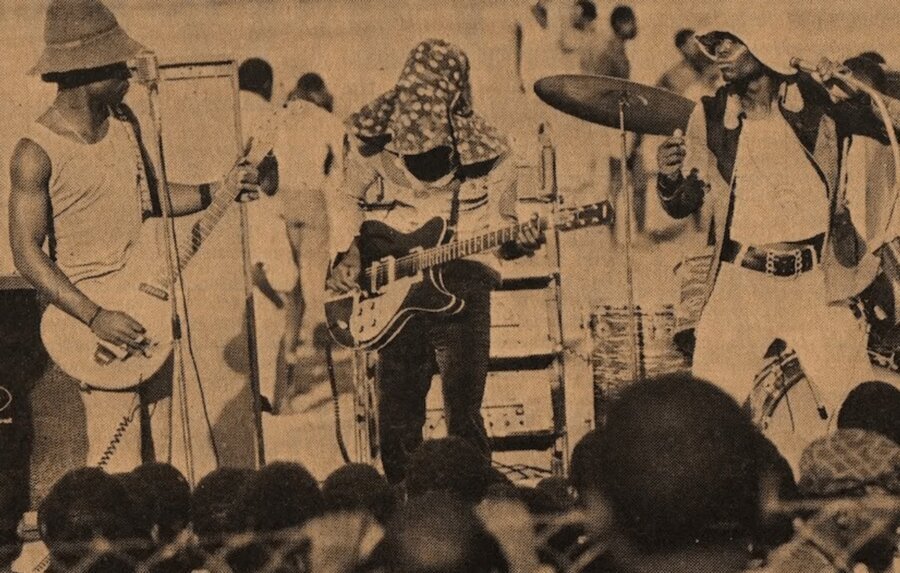The rise, fall, and renaissance of Zamrock: The story of Zambia’s forgotten 1970s rock scene
As a new documentary about WITCH (We Intend To Cause Havoc) - one of Zamrock’s leading bands - is released, we take a trip down memory lane and delve into one of the earliest manifestations of rock music in Africa.
When talking about music in Africa, few would connect rock to the continent, and even fewer would imagine that Zambia had a thriving rock scene in the 1970s. But for ten years, the stars aligned perfectly for a number of Zambian musicians blending African rhythms, funk, garage and psychedelic rock, allowing them to lead an unparalleled musical movement.
In order to understand how this movement came to be, we have to go 57 years back in time. In 1964, Zambia became independent from the United Kingdom and managed to seize control of its biggest industry, copper mining.
This led to an economic boom by the close of the decade. It improved the population’s purchasing power and Zambians were able to afford spending money on entertainment. At the same time, the British upper class who stayed in Zambia had been importing rock records of popular artists at the time, such as Jimi Hendrix, The Beatles, Deep Purple, The Rolling Stones…
This led to a whole generation growing up listening to these bands. Some of them even picked up instruments and started imitating their heroes. Jimi Hendrix’ “Hey Joe” was a particularly popular song among Zambians learning how to play the guitar.
Soon enough, these young musicians started forming cover bands like The Lusaka Beatles or Rev 5 (The Rolling Stones cover band) and realized there is even an audience for what they had been passionately doing. The country’s young work force had money to spend on concerts, and these bands started performing in miners’ taverns and hotels. They quickly realized that this was a perfectly viable way to make a living, and much more gratifying than what the job market had to offer.
At the turn of the decade, this burgeoning music scene got a massive boost from a political decision: President Kenneth Kaunda decreed that Zambian radios must play 90% of Zambian music. It was the perfect opportunity for these youngsters to start writing original music since releasing an album was synonymous to getting radio airtime.
The first ever Zamrock album was “WITCH – Introduction”, a frenzied garage rock record that had to be made in Nairobi, Kenya, which was the closest place with a record press. It opened the doors the many more bands that followed in WITCH’s footsteps like Ngozi Family, The Peace, Musi O Tunya, Salty Dog, Amanaz…
Their atypical sound and relentless energy on stage (WITCH were known to play live shows that could last up to seven hours) made them even compete in the local market with western records. They were ultimately more relatable that western acts, and they reflected the spirit of that era. Zamrockers could fill up stadiums of thousands of people and were even able to tour in neighbouring countries such as Botswana, Zimbabwe and Malawi.
Unfortunately, the Zamrock movement started losing steam at the end of the decade, and a dramatic turn of events brought it to a premature end.
The drop in global copper prices - which represented 95% of the country’s export earnings - engendered an economic decline which meant that records and concert tickets were not as affordable as they used to be. Moreover, the instability of the political situation in neighbouring countries encroached on Zambian borders and led to frequent curfews and power cuts which made gigs very difficult to organize.
As if this was not enough, the AIDS epidemic started in the country in 1984, and killed about 13% of the Zambian adult population in just six years. Musicians were particularly vulnerable to this because of their rock’n’roll lifestyle and sadly, most of the Zamrockers passed away from complications related to the HIV virus.
Without a market for the music, and without the artists to keep their recordings, the genre consequently fell through the cracks and could have easily been forgotten forever if it was not for a miraculous overseas interest in it, 40 years later.
Some music lovers from Europe and the USA stumbled upon this musical oddity, and some YouTube uploads of Zamrock hits sparked a resurgence of the genre across the globe. A few record labels started digging up Zambian rock archives, remastering and reissuing records that everybody thought were a relic of the past.
It even allowed some Zamrock survivors - like Emmanuel Jagari Chanda from WITCH- to tour Europe and the US, and play in front of new audiences.
Today, Emmanuel Jagari Chanda is almost 70 and is the main flagbearer of Zamrock. The documentary “We Intend To Cause Havoc” by Gio Arlotta retraces the life of the African rockstar and sheds light on this side of African musical history that remains one of rock’s biggest hidden gems.
By Jasmin Nyqvist



